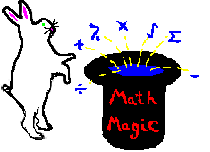

A. Many times we are given (or can find) the probability but the question asks for the odds. So we must change probability to odds.
B. First, let's look at the difference between probability and odds:
probability = # of desirable outcomes
# of possible outcomes
odds = # of desirable outcomes
# of undesirable outcomes
C. One way of looking at this is to look at a simple example involving a coin.
The probability of flipping a coin and getting heads is 1/2 because there are two possibilities [heads or tails].
The odds of getting heads is 1/1 which means the chances of getting heads and the chances of getting tails are equal.
Many times we might say you have a 50-50 chance of getting heads and a 50-50 chance of getting tails. When we use words like this we are talking about odds.
When we say you have a 50% chance of getting heads we are talking about probability.
D. Let's look at how to change from one to the other.
Probability -> Odds:
You should note that the numerator is the same in both probability and odds, so the numerator of the answer will be the same.
To find the denominator (or the number of undesirable outcomes) we should subtract the numerator from the denominator.
Ex [1] If the probability of winning is 7/15, then the odds of winning is __________?
The numerator is the same which is 7.
The denominator is: 15-7 = 8.
The answer is 7/8.
Ex [2] If the probability of losing is 6/17, then the odds of winning is __________?
Notice in this example we are going from losing to winning, not losing to losing. So we must first find the odds of losing, then subtract this value from 1 to find the odds of winning.
The numerator is the same which is 6.
The denominator is: 17-6 = 11.
The odds of losing is 6/11 which means the odds of winning is 5/11. (Just subtract: 1-6/11)
The answer is 5/11.
Odds -> Probability
Again, the numerator is the same in both probability and odds, so the numerator of the answer will be the same.
To find the denominator (the number of possible outcomes) you simple add the numerator and denominator.
Ex [1] If the odds of winning is 6/7 then the probability of winning is __________?
The numerator is the same which is 6.
The denominator is: 6+7 = 13.
The answer is 6/13.
Ex [2] If the odds of losing is 9/10 then the probability of winning is __________?
Notice we are changing from losing to winning, not from losing to losing. So we have to first find the probability of losing then subtract that value from 1.
The numerator is the same which is 9.
The denominator is: 9+10 = 19.
The probability of losing is 9/19 so the probability of winning is 10/19. (Subtract 1-9/19).